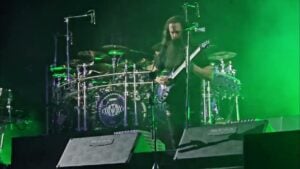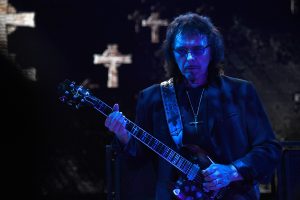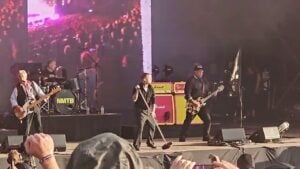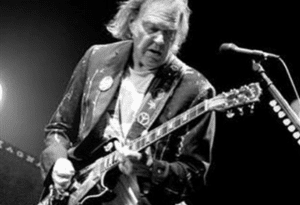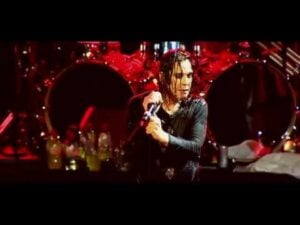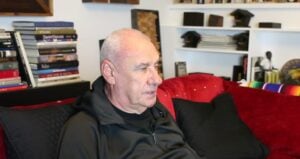Keith Richards’ Guitar History Explored

via five watt world / Youtube
In the ever-evolving landscape of rock ‘n’ roll, there are few individuals whose impact is as profound and enduring as that of Keith Richards. Renowned for his distinctive guitar riffs, gravelly vocals, and rebellious stage presence, Richards has become an emblem of excellence in rock music.
His role as the iconic guitarist for The Rolling Stones not only defined a specific era but also played a central role in molding the sonic identity of an entire musical genre, leaving a mark on the history of rock that continues to resonate to this day.
But apart from his musical legacy, the Human Riff also has something that was almost as great as his riffs: his extensive guitar collection.
From a perspective, Keith’s guitars are a reflection of his success. From the humble beginning of using a cheap plywood Rosetti to his iconic self-modded Telecaster that became known as “Micawber”.
A dream that started with an inexpensive guitar
Born on December 18th, 1943, Keith Richards started his guitar journey with modest beginnings. His lifelong passion for music started at the tender age of 15 when, with ardent persuasion, he convinced his mother to buy him a plywood-made Rosetti acoustic guitar.
Keith learned a few chords from his father. But after that, he became content to teach himself by repeatedly listening to blues and rock and roll records to learn the songs. According to his mother, he learned how to play “That’s All Right, Mama” by Elvis Presley as his first tune. The future riff-meister was trading riffs with other students, many of whom were more skilled guitarists than him while hanging out at the art school, and he was loving it.
Undeterred by the absence of formal training, Richards adopted a self-directed approach to mastering the guitar. Diving deep into the rich tapestry of blues and rock ‘n’ roll, Keef immersed himself in the works of his musical idols, absorbing the nuances and intricacies that would eventually contribute to the formation of his unmistakable and influential style.
This period of self-discovery and relentless dedication laid the groundwork for the future icon, setting the stage for the incomparable contributions he would make as a guitarist, songwriter, and a driving force behind The Rolling Stones.
Starting a band with his second guitar
At first, Richards gave more importance to his earnest goal of becoming a guitar master than to joining a band. But things took a big turn when he happened to run with his childhood pal Mick Jagger on a train grappling with an armful of rock and blues CDs. Another buddy of the two from grammar school, Richard Clifford Taylor, was crucial in bringing the two musicians together in the early days of the Rolling Stones.
When the group first came together, it was made up of this trio of budding rockstars. Jagger’s vast library of blues records—which included artists like Chuck Berry, Jimmy Reed, and Muddy Waters—provided the group’s musical inspiration.
Even though it took a long six months for Jagger’s direct orders from Chess Records in the United States to materialize, they gave the trio access to a range of music that they might not have otherwise heard.
Richards’s musical career took off when he bought his second guitar, a Gallotone Valencia made by a South African firm that became well-known in London during the skiffle era. Richards creatively transformed this basic F-hold guitar into a vehicle for his artistic creativity by skillfully enhancing its powers with an inexpensive Japanese pickup.
“The Rollin’ Stones” at Marquee Club
By 1962, Richards and Jagger had become acquainted with Alexis Korner through the London music scene. Inspired by the Chicago blues sound, Korner founded Blues Incorporated with future Stones Charlie Watts on drums, Cyril Davies on harmonica, and Korner himself.
Stones founder Brian Jones would travel 100 hundred miles to the Ealing Club in London, where he assumed the alias Elmo Lewis and joined the band. It was at this time of working with Korner that Keith Richards acquired his first real amplifier, a Selmer Little Giant.
It was at this point that Jagger joined Blues Incorporated as a singer. But when an unanticipated event forced Korner to do a radio show without Jagger, the pre-Stones band seized the chance to take over Korner’s regular Thursday night slot at the Marquee Club. After naming themselves initially as The Rollin’ Stones (from a Muddy Waters song), the group’s live performances began with this.
They then started doing regular shows at the Marquee and Ealing Clubs. In spite of living together and facing financial difficulties, the band realized they needed to upgrade their amplifiers in order to continue their musical journey and avoid famine.
The band is coming along with more gears
One account claims that the band was able to purchase a pair of Harmony H306 amplifiers thanks to a loan from Mick Jagger’s father. These amps were ideal for the band because they had an integrated tremolo, a 12-inch Jensen speaker, and four inputs.
Bassist Bill Wyman arrived and brought with him a Watkins Westminster amp and—most importantly—a Vox AC 30, a piece of gear that the band could not have afforded before.
Charlie Watts finally gave in and became a member of the Rolling Stones in 1963, a turning point that greatly increased the band’s profile. After Jones bought a Harmony Stratotone guitar in January 1963, Richards was also able to obtain a brand-new Harmony Meteor H70 electric guitar on credit.
Because they frequently saw their American blues stars playing harmony guitars on album covers, the London blues scene came to appreciate Harmony guitars. The H70 model had a single cutaway and a thin hollow body. It had two gold foil-style pickups and two volume and two tone knobs. Production of this guitar type lasted from 1958 until 1966.
Keith’s new Harmony plus a Vox deal for amp supplies
Keith Richards next acquired a Harmony 1270 Flat Top 12-string guitar in February not too long. Built with a spruce top, a mahogany back, and a truss rod neck, this guitar was used extensively in song recordings, contributing to the writing of songs such as “As Tears Go By”. It was also featured heavily on the album Not Fade Away, especially in the opening riff of “Tell Me”.
It is important to note that in those days, guitars in bands were frequently seen as shared property that any member might use. As a result, even if one member might buy a guitar, other members of the group would often end up using it.
In particular, the story of Keith Richards’ guitars will be entwined with the guitar acquisitions made by his bandmate Brian Jones. In 1963, Jones expanded his collection with a Gretsch Anniversary guitar. This means that Keith would sometimes play the Anniversary when Brian took over harmonica duties for a song.
An important turning point for the band came that July of the same year when they signed a formal sponsorship deal with Vox. Bill Wyman received a T60 bass amp as a result of the endorsement, and the band was given two black Top Boost AC30s with supports. Notably, Vox gave the band a modified AC30 head to use with the T60 speaker cabinet because the solid-state construction of the T60 bass amp proved to be unreliable.
Keith’s iconic Epiphone Casino
The Rolling Stones made a huge breakthrough in 1964, which also brought them greater financial security.
In an interview, Keith Richards answered straight when asked what his dream partner was. “I’d say a guitar. Some of my friends have said that I’m in love with guitars, and they could well be right.”
In late May of that year, Keith added something special to his collection of vintage guitars: an early 1962 Epiphone Casino ES-230 TDV, which shared production lines with the Gibson ES-330 in Kalamazoo and had a headstock styled after Gibson from the early model year. Inspired by an early Bigsby trim design, Keith’s specific model included the Tremotone vibrato, which is only available on Epiphones.
Gibson’s historical records show that in 1962, just 211 Epiphone Casinos—which had a catalog price of $314.50—were produced. In the middle of the 1960s, Richards used the Casino a lot as his main guitar. Unlike the 335, which has a center block and is semi-hollow, the Casino is totally hollow. But as the band’s popularity and volume increased, so did the difficulties in getting feedback.
The famous Les Paul Sunburst that Keith bought secondhand
The Stones went on an immediate tour after returning to England, and it was during this tour that Vox gave Brian Jones a Phantom six-string and a Vox Mark III electric 12-string. In 1964 and 1965, these two white Vox guitars would become Brian’s trademark instruments, and Keith Richards would often use them in his own performances.
Richards acquired a noteworthy item in August 1964 when he bought a used ’59 Les Paul Sunburst Standard in London. From a historical perspective, this acquisition was made over two years before Eric Clapton’s world-shaking Les Paul and Marshall combination on the pioneering Beano album, which was released in July of ’66.
The Burst was bought by Keef from John Bowen of Mike Dean & The Kingsmen who purchased it brand-new in 1961 and added a Bigsby shortly after. Keith started using the Les Paul as his main guitar around September of 1964. “It was my first touch with a really great classic rock and roll guitar, so I fell in love with them for a while,” he said, thinking back on the instrument.
At this time, Richards became the first well-known R&B performer in the UK to perform with a Sunburst Les Paul, which increased his impact on the developing rock and roll scene.
The white Telecaster that influenced a generation
In their September 2 recording sessions that year, apart from Richards’ ’59 Les Paul, Brian Jones also played a white Telecaster that he had recently acquired. This Telecaster, new for that year, had a white alder body, a maple neck with a rosewood board, and three threaded steel saddles.
According to Andy Babiuk’s 2014 book Rolling Stones Gear, it was the first example of the Telecaster’s prominence, so it was a window into the future. Interestingly, Richards debuted a brand-new six-string acoustic Framus Jumbo 597 model during this performance.
On October 24th, the second Stones tour of the United States got underway, and they made an appearance on the Ed Sullivan Show the next day. Keith used his Les Paul to perform “Around and Around” and “Time Is on My Side” live, and the Telecaster supported both Brian and Keith on their tour. They used rental Fender amplifiers for every show on the trip.
The promoter decided not to pay for the Vox amplifiers’ delivery during their Australian tour. Rather, Jones and Richards were given a backline made up of two piggyback Fender Showman amps. The band made a detour in California on their way back to England from Australia when Brian and Keith bought Showman rigs. These rigs, which included a 15-inch speaker cabinet, four six power tubes, and a two-bass harmonic tremolo, were used in place of their AC-30s. The Stones would spend a considerable amount of time on stage with these amplifiers.
Keef’s New Firebird VII and fuzz amps from a deal with Gibson
During one of their tour dates in the US, the Band stopped in Chicago and was able to work out an endorsement agreement with Gibson. Keith and Brian ended up owning matching Firebird VIIs, which at the time were thought to be Gibson’s best models. Even when it was first released in 1963, the Firebird was a revolutionary addition that had a big influence on stage.
These guitars were specially constructed to bridge the gap between small humbuckers and single-coil sounds. They came with three different Firebird pickups. Many guitar builders advise looking into a Firebird pickup if you want a powerful single-coil tone without the buzz that often goes along with it.
Each band member received a Gibson Heritage Flat Top as payment for the endorsement. This 25.5-inch scale, square-shouldered model was first introduced in 1965 with the intention of taking direct aim at Martin’s Dreadnoughts. The Heritage’s bottom bout measured 16.5 inches, making it 0.5 inches wider than the Martin’s. It had a spruce top, rosewood sides and back, with binding in the tortoiseshell pattern.
A number of Maestro FZ-1 fuzz pedals were also given to the band by Gibson because Keith Richards was known to be brutal on the pedals during performances, requiring replacements on a regular basis. Richards played the freshly acquired Firebird through the fuzz during the song’s famous riff, which was enhanced by the Heritage model’s acoustic guitar section.
Keef switching seamlessly between a Freshman, a Firebird, and a Gibson Maestro
Keith bought a 1960-released Gibson Hummingbird acoustic guitar around the same period. His version included a spruce top, an adjustable saddle bridge, and a mahogany back and sides. Keith quickly adopted the Hummingbird as one of his go-to acoustics, and it can be heard on many of his albums.
The iconic guitarist also added a Guild Freshman Model M-65 guitar to his collection in the first few months of 1966. The 24 and three-quarter-inch scale length, totally hollow body for increased resonance, and remarkable lightness of the instrument were noted in the Guild catalog.
The Freshman guitar weighed a scant five pounds, according to the catalog. Up until the start of November ’66, Keith’s M-65 served as his main instrument for both live performances and recording sessions.
A set of Non-Reverse Firebird VII model guitars was delivered to the Rolling Stones just before their 1966 Australian tour. With its updated Firebird body form, the Seven model stood as the line’s high point. The band stopped in New York to record an appearance on The Ed Sullivan Show before heading off on tour in Australia. Keith used his Guild Freshman M-65 for this performance, switching to the Gibson Heritage acoustic for “As Tears Go By” and the Gibson Maestro Fuzz for “Satisfaction” and “19th Nervous Breakdown”.
One of Keith’s all-time faves, the Black Beauty
During a brief European tour in March of that year, Keith mostly used the Guild Freshman M-65. But he also added a new Maple Cap Neck Telecaster in sonic blue, a feature first introduced in ’65. On July 25, the day of the Hollywood Bowl show, Keith bought a 1952 Goldtop Les Paul on the Stones’ summer tour across the United States in 1966.
Interestingly, the strings on the ’52 model’s wraparound tailpiece passed beneath the bridge, making it impossible for the player to mute the instrument with their right hand. This design flaw was later fixed in the ’53 model. On Richards’ ’52, however, the tailpiece type is not mentioned.
The band immediately traveled to New York for another appearance on The Ed Sullivan Show after wrapping up the RCA sessions in September. Keith debuted the late ’50s Les Paul Custom “Black Beauty” guitar during this performance; he used it extensively during the Tour of Britain that fall, including the appearance at the Royal Albert Hall with acts like the Yardbirds and Ike and Tina Turner.
Richards continued to acquire guitars, but for the most part, he used his Les Paul Custom during the first sessions at Olympic Studios in October. Occasionally, when he needed an acoustic sound, he grabbed for his Hummingbird and occasionally switched to the Non-Reverse Firebird for somewhat different electric tones.
Keith falling in love with Fenders
Richards debuted his Guild F-212 acoustic 12-string, a model that Guild had released in late 1963, during the Olympic Studios session. The guitar has a spruce top, a tortoise-style pickguard, and a mahogany back and sides.
Late in March 1967, Keith expanded his collection with a Gibson ES 330 TD. Usually, new guitars were added to the repertoire, such as this one for Keith, to incorporate guitars into it. During the European tour in March and April of 1967, Keith continued to be devoted to his Les Paul Custom, while Brian Jones mostly performed on the ES 330 TD.
Keith’s switch to the Telecaster was highlighted in a 1967 promo film called 2000 Light Years from Home, which featured him strumming his distinctive blue Telecaster. When asked about that time, Keith explained:
“Around ’67 or ’68, that’s when I really started to get to grips with Fenders. Before that, I was using Gibsons and any other guitars that came my way through Fender amps. Then I realized the Leo Fender genius was matching the amp with the guitar. And also, the Telecaster, for all its distinctive sound, is capable of quite a lot more than you’d expect. If you play around with it and put a humbucker on the top, it’s really versatile.”
Keith and his sun-and-moon-painted Black Beauty
When the Rolling Stones started working with American producer Jimmy Miller and engineer Eddie Kramer in 1968, they were entering a famous collaboration that would last until 1973. Together, they created timeless hits like “Jumpin’ Jack Flash”, “Honky Tonk Women”, “Brown Sugar”, “Tumbling Dice”, and “Angie”.
This was a significant period in Stones’ history because it saw the band return to their core blues influences, and Keef continued to experiment with open tunings, which helped to create the unique sound of his rhythm sections. Interestingly, he played “Street Fighting Man” from Beggars Banquet in open D tunings.
Richards’ style was influenced by players from the 1920s and 1930s, including Blind Willie Johnson and Bo Carter. At this stage, Richards and Jagger had taken over as the band’s main songwriters.
In the short clip that goes with “Sympathy for the Devil”, Keith and his girlfriend Anita Pallenberg creatively affixed a moon and sun to Keith’s Les Paul Custom. Until the 1970s, when he also began to own another Black Beauty without the artwork, this customized Les Paul was his main instrument.
https://twitter.com/ishi_kokoro/status/1367064045891641347
Richards used a Maton guitar until its neck fell off
During the Beggars Banquet recording sessions, a brand-new Gibson SJ-200 acoustic guitar with specs from the mid-1960s became noticeable. This guitar was tuned to Nashville by Keith, and it was heard on “Wild Horses”, played so expertly by Mick Taylor.
With the year 1969 coming to an end, the band’s main priority became recording the songs for the Let It Bleed album, which was completed in February and early July. Of the instruments played on these recordings, Keith was especially fond of the Maton Supreme Electric 777, an Australian-made electric guitar that he acquired in November 1968, when he was still mostly using his modified Moon Les Paul Custom.
During these recordings, Keith learned to love the Maton guitar, with its thin-line single cutaway design, acoustic-electric nature, 24.5-inch scale, twin Mountain Magnum metal high-power pickups, and factory stock Bigsby vibrato.
Pictures from the recording sessions showed Mick, Keith, and Brian taking turns to play the Martin. But toward the end of the sessions, the guitar—which had been stripped and refinished—literally came apart after months of heavy use; the neck snapped off as the last notes of “Gimme Shelter” were played.
The Human Riff’s famous open G tuning
Keith firmly adopted his distinctive open G tuning in 1969; this would characterize nearly every Rolling Stones record that followed. The under-appreciated solo musician Ry Cooder was brought in by the band for a couple of sessions. Even though Keith had known about the tuning before, this was the first time he’d seen someone actually play it.
Using a slide, Ry Cooder enthralled Richards with the chord possibilities. Keith made a significant change to his guitar by removing the low E string, leaving him with five strings tuned to G, D, G, B, and G. After feeling a little stagnant on the guitar for a while, Keith’s creativity was sparked by playing these five chords in open G.
Thinking back on this alteration, Richards said that the restrictions spurred his imagination, saying, “It restricts you so much—five strings, three notes, two fingers, and one. There’s something about being restricted that opens up the possibilities.” He also said that the electric rendition of “Honky Tonk Woman” was probably the first recording to use a Telecaster setup with the five-string open G tuning, setting the stage for the following forty years.
Mick Taylor entered the studio as Brian Jones’ substitute for these recordings. Taylor’s connection to the Stones began when he bought Richards’ 1959 Les Paul guitar while he was a member of Mayall’s Bluesbreakers. As a result, Keith’s original ’59 Les Paul made a roundabout way back into the band’s guitar collection.
https://twitter.com/Rollin50s/status/1248306703348703233
The death of Brian Jones
Due to Brian Jones’s drug problems, the band decided to split up with him by June 1969 because his output had gradually decreased. It was announced on June 13 that Mick Taylor would take over as Brian’s replacement. Sadly, on the evening of July 3, Brian’s body was found dead in his swimming pool.
Keith reflected on his friendship and collaboration with the iconic Stones founder, saying, “I used to tell Brian that he wasn’t going to live to see 30.”
By the end of June that year, Richards acquired a 1958 Gibson Flying V, which Wyman claimed had once belonged to Albert King. The Flying V was included in Gibson’s lineup of guitars that are often known as Korina guitars. These guitars were only made in 1958 and 1959 since they were viewed as a flop at the time of launch.
Before it was tragically taken in October of 1971 in France, Keith’s favorite guitar was the Flying V, which he acquired very fast. He played the guitar for the first time at the summer 1969 Hyde Park event, and he also played it live on Top of the Pops.
The Dan Armstrong Plexiglass prototype, another iconic guitar
The famous luthier Dan Armstrong gave Keith a prototype Plexiglass guitar in the late spring of 1969, which was the first of at least four versions that he would go on to own from Armstrong. Keith used the Dan Armstrong Plexi guitar as his main instrument for the band’s first U.S. tour in almost three years while they were getting ready for the trip. As a result, it grew to be linked to Keith just as much as his Telecaster would years later.
This guitar was offered through Ampeg and had a 24.5-inch scale, a maple bolt-on neck, dot inlays on a rosewood fingerboard, and 24 conveniently accessible frets. It cost $340 according to the 1969 catalog, plus an extra $50 for the case. The guitar was notable for having six distinct pickups, which allowed for a wide variety of sounds to be produced from a single instrument.
Even though he owned other guitars, Keith used the hand-built prototype guitar a lot during the last sessions of Let It Bleed. Taylor’s contributions and Keith’s ’59 Burst were now part of the collection of guitars used in these recordings.
On the cover of Get Yer Ya-Ya’s Out!, Charlie Watts held this particular Burst guitar in his left hand; in his right hand, he clutched the prototype Armstrong Plexi guitar.
Keith’s beloved five-string Rick and Micawber guitars
A 1969 Gibson ES 355 TD SV walnut finish, a premium version of the ES 335 series that Gibson first debuted in ’58, was another recent addition to Keith’s guitar collection that same year. The session also featured new acoustic guitars, such as a 1969 Martin D 12-20 and a 1930s National Style O Resonator guitar. Richards would later combine the Martin with his first 12-string acoustic, the Harmony.
The Stones were having financial difficulties in Britain, where they were effectively paying 90 percent of their revenues in taxes. They went to France and started working on what would become Exile on Main St. It was in this period that Keith purchased a modified solid-body Rickenbacker from an eighteen-year-old luthier called Ted Newman Jones III, who would go on to become not only Keith’s tech.
Five strings were used on the Rickenbacker, which was the first of many five-string guitars that Jones would build for Richards. Most famously, Keith began playing a 1954 Telecaster in butterscotch blonde that Eric Clapton had given him as a birthday present when he was 27. Since 1971, he has been playing the same guitar, which he lovingly calls Micawber.
The most noticeable change is the humbucker installed in place of the neck pickup. A solid brass bridge with heavy brass saddles has been installed in place of the old bridge. The guitar has been modified for open tuning and five strings by removing the bottom E saddle. The 17th fret’s fret marker is absent and hasn’t been restored. The guitar’s finish bears noticeable wear patterns from Richards’ strumming technique, especially in the upper half of the neck.
The Nellcôte burglaries and the heartbreaking loss of his collection
Just as the Exile recordings in Nellcôte, France were coming to an end, many guitars were unfortunately taken in a string of burglaries. In the first instance, Wyman’s Mustang bass and the Albert King Flying V were among the nine guitars that the thieves stole while Keith was at home watching TV.
Reports state that during a later break-in at the same spot, Keith’s whole collection—which included Gibsons, Mustangs, Les Pauls, and Hummingbirds—was taken while the band was asleep. Keith estimated the value of the collection at $44,000 when he completed the insurance form the next day.
Though accounts may differ, it seems that among the guitars lost in the end were the Flying V, the prototype Dan Armstrong Plexi, the Ted Newman Jones Rickenbacker, the ’59 Gibson Les Paul, one of the Hummingbirds, Keith’s Gibson three-pickup Custom Black Beauty, and Keith’s ’64 Telecaster with the rosewood fingerboard.
At the time, Keith said, “I didn’t want to think about it. But I slowly started to build up a collection since then. I haven’t lost one since I learned my lesson: Don’t leave them hanging around on a Saturday night.”
The guitar history of a riff icon
Keith Richards’ guitar history reads like a dynamic narrative within the larger story of The Rolling Stones. From his humble beginnings with the Rosetti acoustic guitar at the age of 15, Richards embarked on a musical journey that would forever shape the landscape of rock ‘n’ roll.
The evolution of Richards’ guitar collection reflects the band’s rise to global prominence and the transformative moments in their musical journey. From the early financial struggles symbolized by the acquisition of better amplifiers to the endorsement deal with Vox and the subsequent expansion of their sonic palette, each guitar carries the echoes of a specific era.
The setbacks, such as the burglaries during the Exile sessions, underscore the emotional significance of these instruments, serving as reminders of hard-earned lessons and the enduring passion for the craft.
As Richards embraced new tunings, experimented with various models, and navigated the changing landscape of rock music, his guitars became more than tools of expression—they became characters in the unfolding saga of The Rolling Stones. From iconic models like the Gibson Hummingbird to the personalized modifications of Micawber, each guitar bears witness to the enduring legacy of a guitarist who not only shaped an era but continues to influence the very essence of rock ‘n’ roll.





